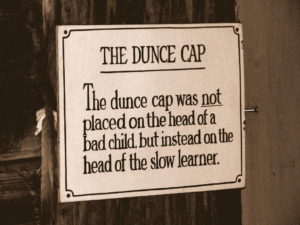
via leighgoldian.com
40-40-20 Plan called an Aspirational Goal, like a wish list
From The Oregonian in 2012:
40 percent of the state’s adults with four-year college degrees, 40 percent with two-year degrees or the equivalent, and the remaining 20 percent with high school degrees.
It would be an impressive advance, since the four-year number is now closer to 30 percent and the two-year degree number way lower than that. The state is so proud of the goal that the last legislature made it law.
An Aspirational Law?
Maybe you’ve heard of the Suggested Speed Limit?
The maybe stop, maybe not, Stop Sign Rule?
Now the rest of the nation is fitting Oregon for the pointy hat, seeing it as the educational outpost it’s trying so hard to change.
Whether you carry a college degree or high school diploma, how hard is it to see Oregon’s educational ranking?
From takepart:
The 2011-12 school year marked the first time since record-keeping began in 1977 that the nation had less money than the year before to spend on public schools, according to the report by the Census Bureau, “Public Education Finances: 2012.”
But Oregon’s situation was bleaker. Unadjusted spending per student fell from $9,800 in 2008-09 to less than $9,500 in 2011-12 even as inflation rose. That left Oregon spending 11 percent less per student than the national average, the biggest gap by which it has ever trailed U.S. spending on schools.
That’s no way to achieve the 40-40-20 plan.
===
No one comes to Oregon to attend poorly funded low ranking schools, but they still come.
What do they bring with them? Hopes, dreams, the works. No one hopes to find the education system in rags, or dream of seeing students fail.
Some of the states with the largest proportions of inbound moves were Oregon, Idaho, South Carolina, South Dakota and Vermont.


